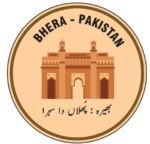The Art of Woodcrafting – Legacy in Bhera, District Sargodha, Pakistan
In the past, Bhera was well known across the subcontinent for its arts and crafts. Among its most celebrated traditions was the intricate wood carving of doors, windows, and jharokas (balconies). The carpenters and woodcarvers of Bhera were masters of their craft, producing work of such excellence that, in the mid-1880s, they were invited to England to contribute to the construction of the Darbar Hall at the Hastings Museum and Art Gallery.
Two prominent craftsmen—Muhammad Baksh and Muhammad Juma—both from Bhera (then part of District Shahpur, later Sargodha), are credited with executing the remarkable woodwork at Darbar Hall (for more details, see Wikipedia – Darbar Hall, Hastings Museum and Art Gallery – 1887). It is said that those who went to England earned enough to return home in prosperity—and proudly referred to themselves as Walayties (a colloquial term derived from Walayat, meaning Britain). To this day, there is a mohallah in Bhera known as Walaytianwala.
When Bhera’s woodcraft was on the verge of decline, John Lockwood Kipling, Principal of the Mayo School of Arts and Curator of the Lahore Museum, stepped in to preserve this artistic heritage. Through his efforts, woodcarvers from Bhera were employed by the Kensington School of Arts in London. They were not only provided with travel expenses but also paid respectable monthly salaries.
Kipling played a crucial role in bringing attention to the traditional handicrafts of Punjab. He actively helped local artisans find markets for their work, effectively reviving a dying craft. Thanks to his commitment, Bhera’s woodcraft enjoyed a renaissance that lasted nearly another century. For many years, artisans from Bhera provided a steady stream of wooden masterpieces for foreign markets.
Excerpts from: Craft and Craftsmen of Punjab, Vol VII – Crafts of Sargodha, published by the Handicrafts and Design Directorate, Punjab Small Industries Corporation, Lahore (2010).
Notes:
1 . John Lockwood Kipling, CIE (6 July 1837 – 26 January 1911) was an English art teacher, illustrator, and museum curator who spent most of his career in India. He was the father of the famous writer Rudyard Kipling. John Lockwood Kipling began as a professor of architectural sculpture at the Jeejebhoy School of Art in Bombay (now Mumbai), later becoming its principal. In 1875, he was appointed principal of the Mayo School of Arts, Lahore, and also served as curator of the Lahore Museum. Between 1870 and 72, he was commissioned by the British Government to tour Punjab, the North-West Frontier, and Kashmir, making sketches of local craftsmen and notable sites. Many of these sketches are now held at the Victoria and Albert Museum in London.
2 . The Mayo School of Arts, Lahore, established in 1875, was later renamed the National College of Arts (NCA) in 1958. It is the oldest art school in Pakistan and the second oldest in South Asia, after the J.J. School of Arts, Mumbai. The J.J. School was founded in 1857 through the generosity of Sir Jamsetjee Jeejebhoy, a renowned businessman and philanthropist who donated Rs 100,000. for its endowments. (For more information, see Wikipedia – NCA, Lahore, and J.J. School of Arts, Mumbai ) .
3 . Selected photographs of traditional Bhera woodwork are available on the website bhera.org, under the section titled: Arts & Crafts of Bhera. https://bhera.org/arts-and-crafts-of-bhera-once-a-town-of-buildings-and-crafts-bhera-district-sargodha/
4 . A leaflet titled “The Art of Woodcrafting – Legacy in Bhera,” prepared by Enaya Mumtaz, is shared.

